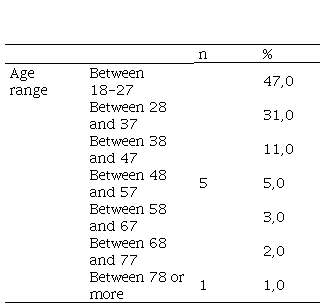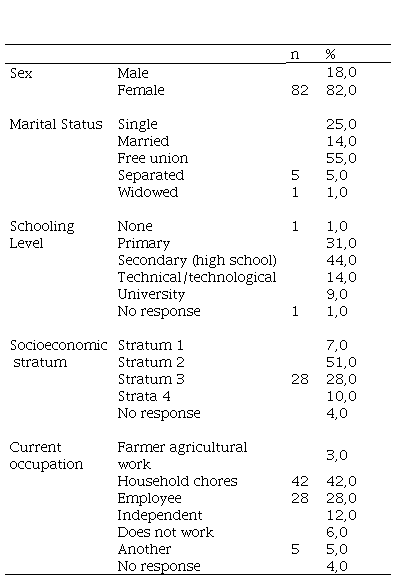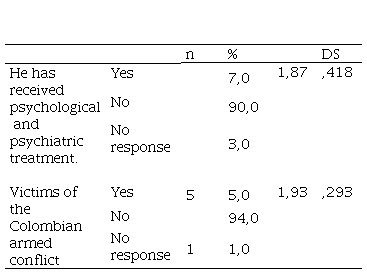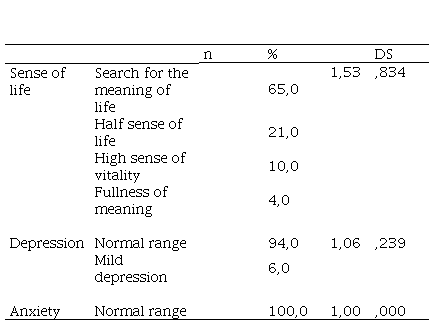Introduction
The rural universe has been redefining itself in recent years, from being considered as a stable structure, organized by dispersed agrarian groups and functionally determined at the social level, to a complex and dynamic system in constant change and movement, organizationally diversified into multiple structures interrelated among themselves and with the urban (Dirven, 2019; Vera, Osses, and Shiefelbein, 2012; Shanin, 1979).
Colombia, is a country with a geography that presents high percentages of rural areas, with varied socioeconomic developments (Fonseca, Contreras, Porras and Vargas, 2017; Forero, 2003; Pérez and Pérez, 2002; Salgado, 2002); where, according to the agrarian census conducted by the Dane (2015), a large part of the Colombian rural population lives in poverty and exceeds 39 years of age; however, despite these conditions, health coverage has been increasing by up to 96.1% as shown by Dane data. However, it is necessary, as stated by Rodríguez and Benavidez (2016), to take into account the specific health needs of the rural population when implementing health approaches.
In this context, the mental health of the population in rural areas is a priority that has to be addressed taking into account its own particularities, so several authors have conducted studies on the characteristics of health-related variables in this population context, identifying the importance of these variables in the analysis of psychosocial and mental health needs in rural population (Camargo and Castañeda, 2019; Rey, Martínez, & Londoño, 2017; Ingelse & Messecar, 2016; Shidhaye, Gangale, & Patel, 2016; Arnautovska, Mcpredran, & De león, 2014). Taking this into account, among the variables related to mental health to be highlighted are, among others, meaning in life, depression and anxiety.
The interest in studying positive psychological variables related to mental health has been increasing in the last decades, and thus the meaning of life has stood out among these, which can be defined as "the affective and cognitive perception of values that invite to act in one way or another, before a particular situation or life in general, giving the person coherence and personal identity" (Martínez, 2014, p. 66), and which contrasts with the meaning of specific situations of life, since the latter does not give meaning in itself to the life of the person (Martínez, 2007). 66), and which is contrasted with the meaning of specific life situations, since the latter does not give meaning in itself to the life of the person (Martínez, 2007).
Research on people's mental health and meaning in life, both at a general level and in clinical samples, shows that the latter is positively correlated with quality of life and negatively correlated with problems such as depression and anxiety (Martínez, Rodríguez, Díaz del Castillo, & Pacciolla, 2015; Velázquez & Martínez, 2015; Arango, Ariza, & Trujillo, 2015).
However, in the review carried out for the present research, it was not possible to evidence studies on the meaning of life in specifically rural samples; the research found focused mainly on clinical patients with various psychological and biomedical pathologies or in some cases general populations of an urban nature such as students (Camargo, Castañeda, & Días del Castillo, 2020; Cadavid-Claussen & Díaz-Soto, 2015; Arango, Ariza, & Trujillo, 2015; Martínez & Castellanos, 2013).
On the other hand, among the negative variables that affect mental health are depression and anxiety; depression is considered a mood disorder that manifests clinically significant symptomatology around feelings of sadness, guilt, low self-esteem, loss of interest and reduced pleasure, affecting sleep and generating feelings of physical exhaustion and low concentration (WHO, 2017) and anxiety as a disorder, refer to an exaggerated reaction at the psychophysical level to harm or potential future fatality and comes accompanied by feelings related to dysphobia and physical tension (Navas and Vargas, 2012; Working Group, 2008).
Depression and anxiety are often associated with the same clinical picture, with symptoms associated with depression-anxiety becoming evident in an increasing number of patients, with statistics showing that up to 50% of the general population in recent years has presented simultaneous diagnoses of these two disorders (Serrano, Rojas and Ruggero, 2013; WHO, 2016).
As far as rural population is concerned, the number of studies found in relation to depression and anxiety is lower than that of urban population and in some cases these studies are comparative (Camargo and Castañeda, 2019), being so, that some have compared the prevalence of these disorders in urban and rural population, finding higher scores of anxiety and depression in city populations (Gutiérrez and Portillo, 2013; Festorazzi, Rodríguez and Lotero, 2008 ).
Regarding depression, Shidhaye, Gangale and Patel (2016), evaluated the prevalence in a rural population of Viarhha in India in a sample of 1900 people, finding percentages around 14.6%. And He, Fan, Liu, Li, Li, Wang, Williams and Wong (2012) in a rural area of China, showed that, among the 875 children studied, those with a low level of social support were more likely to present clinical depression.
Taking into account the existing scientific literature on the meaning of life, depression and anxiety and their relevance to mental health in the population in general and the rural population in particular, the objective of this research was to identify the levels of meaning of life, depression and anxiety in the rural population of a municipality of Cundinamarca-Colombia.
Materials and methods
The present research was framed within the quantitative methodology of descriptive type, since it sought from the analysis of descriptive statistics, to determine the frequency of the variables studied in a fixed time interval (Hernández, Fernández and Baptista, 2010).
The target population of the study was rural inhabitants of a municipality in the region of Cundinamarca-Colombia and consisted of a non-probabilistic-voluntary sample of 100 people between the ages of 18 and 80 years.
Four data collection instruments were used, which were: 1). A sociodemographic data sheet, which was constructed to determine general sociodemographic characteristics such as age, marital status, socio-economic stratum, among others; 2). The Sense of Life Dimensional Scale - EDSV, which has the purpose of evaluating the level of sense of life and is made up of 18 items with Likert scale-type response options, ranging from totally disagree to totally agree. The overall score of the instrument ranges from 0 to 54, with an internal consistency of (.94) in Colombian population (Martínez, Trujillo, Díaz del Castillo, & Jaimes, 2011); 3). The Zung scale for depression (EZ-D), which is a depression screening instrument that evaluates symptoms present during the last weeks. It consists of 20 items with Likert scale response options, ranging from 25 to 100, where 40 or more means that clinically significant symptomatology is manifested. It has an internal consistency of (.548) to (.848) for Colombian population (Lezama, 2012; Campo-Arias, Díaz-Martínez, Rueda-Jaimes and Barros-Bermúdez, 2005); 4). The Zung scale for anxiety (EZ-A), which is an anxiety assessment instrument that evaluates symptoms present during the last month. It is composed of 20 multiple-choice Likert-type items, ranging from 20 to 80 points, with a cut-off point of 50. It has an internal consistency of (.77) for the Colombian population Barros-Bastidas, C., & Turpo, O. (2020) and (De la Ossa, Martínez, Herazo, & Campo, 2009).
Data collection and analysis was carried out once the fieldwork was prepared, proceeding with the visits to the rural population for the application of the instruments; explaining the purpose of the research, as well as the ethical aspects and the signing of the informed consent by those who agreed to participate; subsequently, the instruments were filled out individually, with an approximate duration of application per subject of 25 to 40 minutes. The results were analyzed using the Statistical Package for the Social Sciences (SPSS) for Windows.
Results
Next, the results of the research will be presented at a descriptive level, the measures of central tendency of frequency (n), percentage (%), mean () and standard deviation (SD) of the variables studied.
As shown in Table 1, the age range of the participants ranged from 18 to 80 years, with the highest percentage concentrated in the ages 18 to 27 (47%), followed by 28 to 37 (31%) and with the lowest frequency in those aged 78 years or more (1%). There is a tendency for the size of the sample worked by age range to decrease in percentage as the age of those evaluated increases.
1
Age range of participants

|
n
|
%
|
|
Age range
|
Between
18-27
| |
47,0
|
|
Between 28
and 37
| |
31,0
|
|
Between 38
and 47
| |
11,0
|
|
Between 48
and 57
|
5
|
5,0
|
|
Between 58
and 67
| |
3,0
|
|
Between 68
and 77
| |
2,0
|
|
Between 78
or more
|
1
|
1,0
|
In terms of
sociodemographic characteristics (see Table 2), the sample was made up mainly
of women (82%), with the most frequent marital status being free union (55%), followed
by single (25%) and less frequently widowed (1%); the level of schooling
attained was mainly secondary (44%), followed by primary (31%) and less
frequently no education at all (1%); In terms of socioeconomic stratification,
stratum 2 is the most frequent (51%), followed by stratum 3 (28%) and less
frequently stratum 1 (7%); the most common work occupation was related to
housework (42%) and the least frequent was agricultural work in the fields
(3%).
2
Sociodemographic Data

|
n
|
%
|
|
Sex
|
Male
| |
18,0
|
|
Female
|
82
|
82,0
|
| | | |
|
Marital Status
|
Single
| |
25,0
|
|
Married
| |
14,0
|
|
Free union
| |
55,0
|
|
Separated
|
5
|
5,0
|
|
Widowed
|
1
|
1,0
|
| | |
|
Schooling
Level
|
None
|
1
|
1,0
|
|
Primary
| |
31,0
|
|
Secondary (high school)
| |
44,0
|
|
Technical/technological
| |
14,0
|
|
University
| |
9,0
|
|
No response
|
1
|
1,0
|
| | | |
|
Socioeconomic stratum
|
Stratum 1
| |
7,0
|
|
Stratum 2
| |
51,0
|
|
Stratum 3
|
28
|
28,0
|
|
Strata 4
| |
10,0
|
|
No response
| |
4,0
|
| | |
|
Current occupation
|
Farmer agricultural work
| |
3,0
|
|
Household chores
|
42
|
42,0
|
|
Employee
|
28
|
28,0
|
|
Independent
| |
12,0
|
|
Does not work
| |
6,0
|
|
Another
|
5
|
5,0
|
|
No response
| |
4,0
|
In relation to whether they
have had any type of psychological or psychiatric treatment, most of the sample
reported not having received it (90%); on the other hand, only a small
percentage (5%) stated that they considered themselves victims of the Colombian
armed conflict (see Table 3).
3
Contextualizing questions

|
n
|
%
| |
DS
|
|
He has received
psychological and psychiatric treatment.
|
Yes
| |
7,0
|
1,87
|
,418
|
|
No
| |
90,0
| | |
|
No
response
| |
3,0
| | |
| | | | | |
|
Victims of the
Colombian armed conflict
|
Yes
|
5
|
5,0
|
1,93
|
,293
|
|
No
| |
94,0
| | |
|
No response
|
1
|
1,0
| | |
Table 4 shows
that, with regard to the meaning of life, most of the sample is in search of
vital meaning (65%), followed by medium vital meaning (21%) and, to a lesser
extent, fullness of meaning (4%); with regard to depression screening, it was
observed that the range of normality is very high (94%) and the remaining
percentage presents slight scores (6%); finally, it was found that the entire
sample (100%) scored in the normal range for anxiety.
4
Descriptive data of Sense
of Life, Depression and Anxiety.
 Source: Own elaboration
Source: Own elaboration
|
n
|
%
| |
DS
|
|
Sense of
life
|
Search for
the meaning of life
| |
65,0
|
1,53
|
,834
|
|
Half sense of life
| |
21,0
| | |
|
High sense of vitality
| |
10,0
| | |
|
Fullness of meaning
| |
4,0
| | |
| | | | | |
|
Depression
|
Normal range
| |
94,0
|
1,06
|
,239
|
|
Mild depression
| |
6,0
| | |
| | | | |
|
Anxiety
|
Normal range
| |
100,0
|
1,00
|
,000
|
The objective of this research was to identify the levels of sense of life, depression and anxiety in the rural population of a municipality of Cundinamarca-Colombia, finding that 65% of the sample had low scores on sense of life, which is similar in percentages to other studies in this regard, although with a different population segment (Camargo, Castañeda, & Díaz del Castillo, 2020). On the other hand, it is noteworthy that, in the literature, there is evidence of negative correlation of sense of life with variables such as depression and anxiety in the general population (Martínez, Rodríguez, Díaz del Castillo, & Pacciolla, 2015; Velázquez & Martínez, 2015) and in this case, no such relationship was found, since low scores in sense of life are not statistically accompanied by high scores in depression and anxiety.
Regarding depression screening, it is significant that 94% present scores that fall within the normal range and only 6% score in mild depression, which contrasts with other studies that have found higher percentages of depression in rural population (Shidhaye, Gangale, & Patel, 2016), which could hypothetically be related to greater perceived social support, as has occurred in other research (He, Fan, Liu, Li, Li, Wang, Williams, & Wong, 2012), however, the scope of this research does not allow reaching such a conclusion and further methodological approaches will be required to validate or reject the hypothesis presented here.
On the other hand, some studies show that anxiety levels in rural population are lower than in urban population (Gutiérrez and Portillo, 2013; Festorazzi, Rodríguez and Lotero, 2008) which could not be validated in this research because it is not comparative at population level, but it is close to the results of low anxiety in rural population of those studies, since in the population object of the present research, the clinical levels of anxiety were null, finding that 100% scored in normal range.
At the sociodemographic level, it is highlighted that although statistics in Colombia speak of a greater number of people in rural areas being over 39 years old (Dane, 2015), the sample of this research was mostly people in the range of 18 to 37 years old. Additionally, as described by other authors (Fonseca, Contreras, Porras and Vargas, 2017; Forero, 2003; Pérez and Pérez, 2002; Salgado, 2002), the labor occupation of people in rural areas is varied and is not mainly linked to farm work, at least not, in the sample studied. However, the sociodemographic data of this research are not conclusive, given the biases related to the type of sampling employed, which was non-probabilistic and voluntary.
Conclusions
In conclusion, it can be affirmed that the levels of sense of life in the rural population studied are mainly low, which contrasts with the relatively normal scores in depression and totally normal in anxiety that were found and that go in the same direction of normality of other investigations that evidence less clinical problems in rural population.
The low levels of sense of life cannot be explained in the light of this study, so it is important to formulate new approaches to this construct in the rural population in order to understand the reason for these scores and to know whether they are due to biases in the instrument used or to the characteristics of the sample itself.
On the other hand, a high percentage of the sample does not report having required psychological or psychiatric support or having been a victim of the Colombian armed conflict, which is hypothetically reflected in the normal values for depression and anxiety symptoms.
Among the limitations of this study is the fact that, since it was carried out with such a small, non-probabilistic and voluntary sample, the results should not be generalized to the population and may be due to population biases that are not evident in the research.
On the other hand, it is recommended for future research, to delve qualitatively into the variables studied and their relationship with the cultural and symbolic constructs of the population, in order to have a better understanding.
References
Arango, M.A., Ariza, S. and Trujillo, Á. (2015). sense of life and noological resources in patients diagnosed with major depression with suicidal ideation. Revista Argentina de Clínica Psicológica, 23 (3), 211-221.
Arnautovska, U., McPhedran, S., & De Leo, D. (2014). A regional approach to understanding farmer suicide rates in Queensland. Social psychiatry and psychiatric epidemiology, 49 (4), 593-599.
Barros-Bastidas, C., & Turpo, O. (2020). Research training and its impact on the scientific production of education faculty at a public university in Ecuador. Publicaciones, 50(2), 167-185. doi:10.30827/publicaciones.v50i2.13952.
Campo-Arias, A., Díaz-Martínez, L.A., Rueda-Jaimes, G.E., and Barros-Bermúdez, J.A.. (2005). Validation of the Zung scale for depression in female university students in Bucaramanga, Colombia. Revista Colombiana de Psiquiatría, 34 (1), 54-62.
Camargo, J., Castañeda, J. and Díaz del Castillo, J. (2020). Sense of life and mental health in a group of adults diagnosed with cancer. preliminary data analysis. Science and Technology, 20 (25), 1-11.
Camargo, J. and Castañeda, J. (2019). Bibliometric analysis as a tool for monitoring scientific production in rural psychology. Espirales multidisciplinary journal of scientific research, 3 (29), 86-97.
Cadavid-Claussen, M.V. and Diaz-Soto, V.M.. (2015). Senses of life among university students. Educ.Educ, 18 (3), 371-390.
DANE. (2015). Statistics by subject: Agriculture and livestock. Retrieved from https://www.dane.gov.co/index.php/estadisticas-por-tema/agropecuario
Dirven, M. (2019). New definition of rural in Latin America and the Caribbean in the framework of FAO for a collective reflection to define lines of action to reach 2030 with a different rural sphere. 2030 - Food, agriculture and rural development in Latin America and the Caribbean, No. 2. Santiago de Chile. FAO. 21 p.
De la Ossa, S., Martínez, Y., Herazo, E. and Campo, A. (2009). Study of the internal consistency and factorial structure of three versions of the Zung scale for anxiety. Colombia Médica, 40 (1), 71-77.
Festorazzi, A. Rodríguez, A. and Lotero, J. (2008). Epidemiology of anxiety disorders and depression in adolescents in a rural population. Revista de Posgrado de la VIa Cátedra de Medicina. N° 184, 4-9.
Forero, J. (2003). Economía Campesina y Sistema Alimentario en Colombia: Aportes para la discusión sobre seguridad alimentaria. Environmental and Rural Studies. Pontificia Universidad Javeriana.
Fonseca, V., Contreras, L., Porras, L. and Vargas, A. (2017). State of the art on rural development in Colombia. Revista Cife 30, (30), 121-148.
Working Group (2008). Clinical Practice Guideline for the Management of Patients with Anxiety Disorders in Primary Care. Madrid: National Plan for the NHS of the MSC.
Gutiérrez, J. and Portillo, C. (2013). Anxiety and depression as indicators of mental health problems in Salvadorans. Iztacala electronic journal of psychology. 16 (2), 533-557.
He, B., Fan, J., Liu, N., Li, H., Wang, Y., Williams, J., & Wong, K. (2012). Depression risk of 'left-behind children'in rural China. Psychiatry research, 200(2), 306-312.
Hernández, R., Fernández, C., & Baptista, P. (2010). Metodología de la investigación. Mexico: MacGraw-Hill.
Ingelse, K., & Messecar, D. (2016). Rural Women Veterans' Use and Perception of Mental Health Services. Archives of psychiatric nursing, 30 (2), 244-248.
World Health Organization. (2016). Investment in depression and anxiety treatment has a 400% return on investment. Retrieved from https://www.who.int/mediacentre/news/releases/2016/depression-anxiety-treatement/es/
World Health Organization. (2017). Depression. Retrieved from https://www.who.int/topics/depression/es/
Pérez, E. and Pérez, M. (2002). The rural sector in Colombia and its current crisis. Cuadernos de desarrollo rural. (48), 35-58.
Lezama Meneses, S.R. (2012). Psychometric properties of the Zung scale for depressive symptoms in Colombian schooled adolescent population. Psychologia. Avances de la Disciplina, 6 (1), 91-101.
Martínez, E. (2007). Psicoterapia y sentido de vida: psicología clínica de orientación logoterapéutica (2nd ed.). Bogotá: Herder.
Martínez, E. and Castellanos, C. (2013). Perception of meaning in life in Colombian university students. Pensamiento Psicológico, 11 (1), 71-82.
Martínez, E. (2014). Existential coaching. Based on the principles of Viktor E. Frankl. Bogotá: Ediciones SAPS.
Martínez, E., Trujillo, M., Díaz del Castillo, J. & Jaimes, J. (2011). Development and structure of the sense of life dimensional scale. Acta Colombiana de Psicología, 14(2), 113-119.
Martínez, E., Rodríguez, J., Díaz del Castillo, J. and Pacciolla, A. (2015). Living in the existential way. Aportes para una logoterapia clínica. Bogotá: Ediciones SAPS.
Navas, W. and Vargas, M. (2012). Anxiety disorders: targeted review for primary care. Revista medica de Costa Rica y Centroamérica, LXIX (604), 497-507.
Rey, C., Martínez, J., & Londoño, N. (2017). Differences among rural-urban adolescents in dating abuse. Diversitas Journal, 13 (2), 159-168.
Rodríguez-Triana, D., & Benavides-Piracón, J. (2016). Health and rurality in Colombia: analysis from the social determinants of health. Revista Facultad Nacional de Salud Pública, 34 (3), 359-371.
Salgado, C. (2002). The imagined peasants. Cuadernos de tierra y justicia No 6. Bogotá. ILSA.
Shanin, T. (1979). Peasants and peasant societies. Mexico. Fondo de cultura económica.
Serrano, C., Rojas, A., & Ruggero, C. (2013). Depression, anxiety and academic performance in university students. Intercontinental Journal of Psychology and Education, 15 (1), 47-60.
Shidhaye, R., Gangale, S., & Patel, V. (2016). Prevalence and treatment coverage for depression: a population-based survey in Vidarbha, India. Social psychiatry and psychiatric epidemiology, 1-11.
Vera, D., Osses, S. & Shiefelbein, E. (2012). The Beliefs of rural teachers: a pending task for educational research. Estudios Pedagógicos, 38 (1), 311-324.
Velázquez, C. and Martínez, E. (2015). relationship between core beliefs in personality disorders and meaning in life in university students. Revista Argentina de Clínica Psicológica, 24 (3), 199-210.









